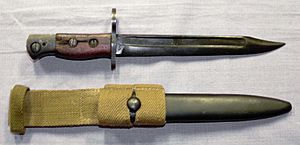No. 5 Bayonet facts for kids
Quick facts for kids No 5 Bayonet |
|
|---|---|

No 5 mk I bayonet
|
|
| Type | Bayonet |
| Place of origin | United Kingdom |
| Service history | |
| Used by | United Kingdom |
| Specifications | |
| Length | 203mm |
The No. 5 Bayonet was a special knife designed to attach to the end of a rifle. It was made for the No. 5 Lee-Enfield rifle, which was often called the "Jungle Carbine."
This bayonet was important because it marked a change for the British Army. Before this, they had been using "socket bayonets," which fit over the end of the rifle barrel. The No. 5 Bayonet brought back the "blade" style, like the older Pattern 1907 bayonet. This meant it had a sharp, knife-like blade instead of just a spike.
The No. 5 Bayonet
The No. 5 Bayonet was a unique weapon. It was shorter than many other bayonets, measuring about 203 millimeters (around 8 inches) long. Its design made it easy to use with the lighter and shorter "Jungle Carbine" rifle.
How It Was Made
There was only one main version of this bayonet, called the No. 5 Mark I. Most of these bayonets were made during World War II.
Many different companies helped produce these bayonets. The company that made the most was Wilkinson Sword in London, producing almost 190,000 bayonets. Other companies like Radcliffe made 75,000, Viners in Sheffield made 42,000, and Elkington & Co made nearly 10,000. After the war, the Royal Ordnance Factory in Poole also made some, but we don't know exactly how many.

